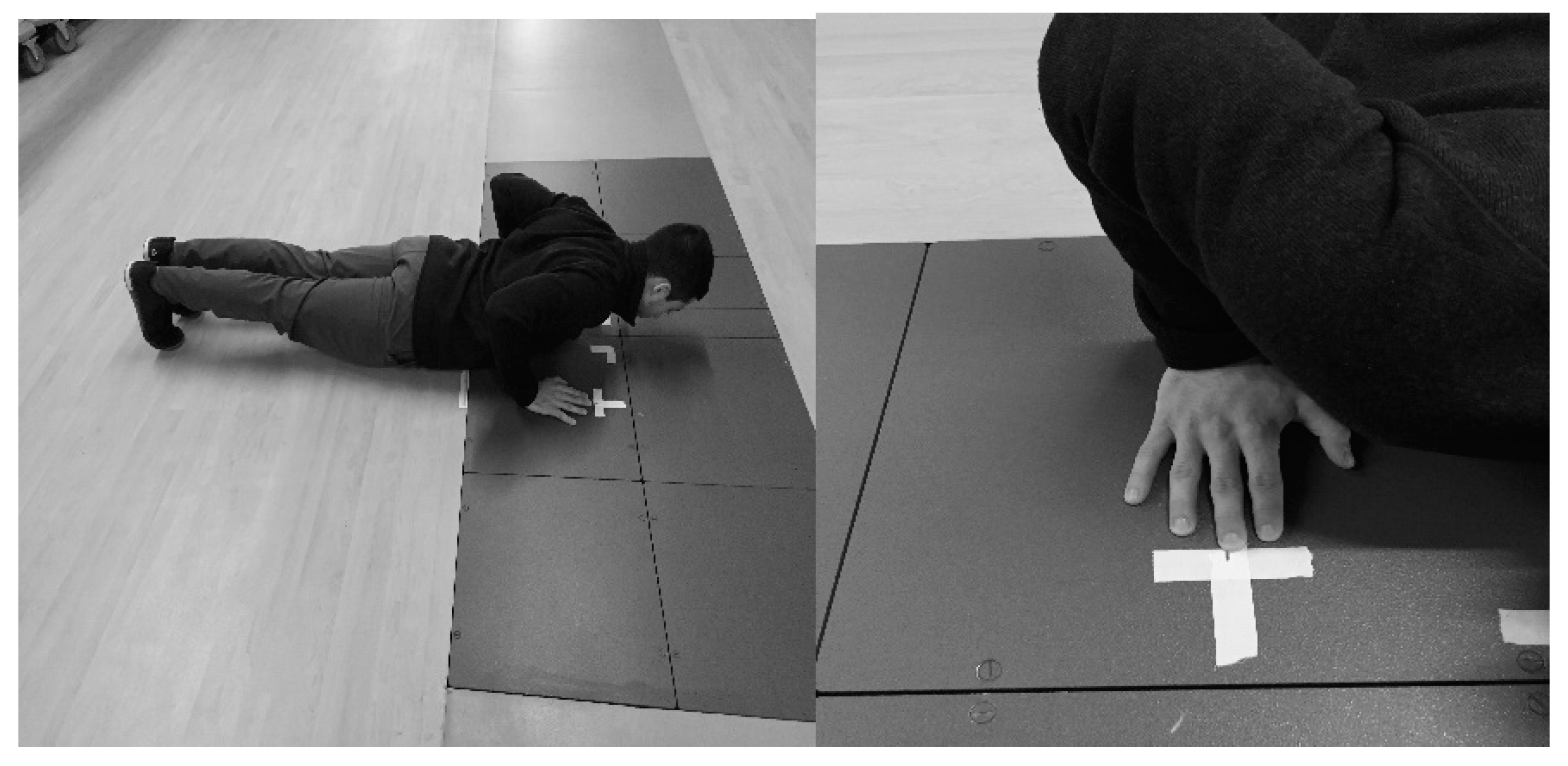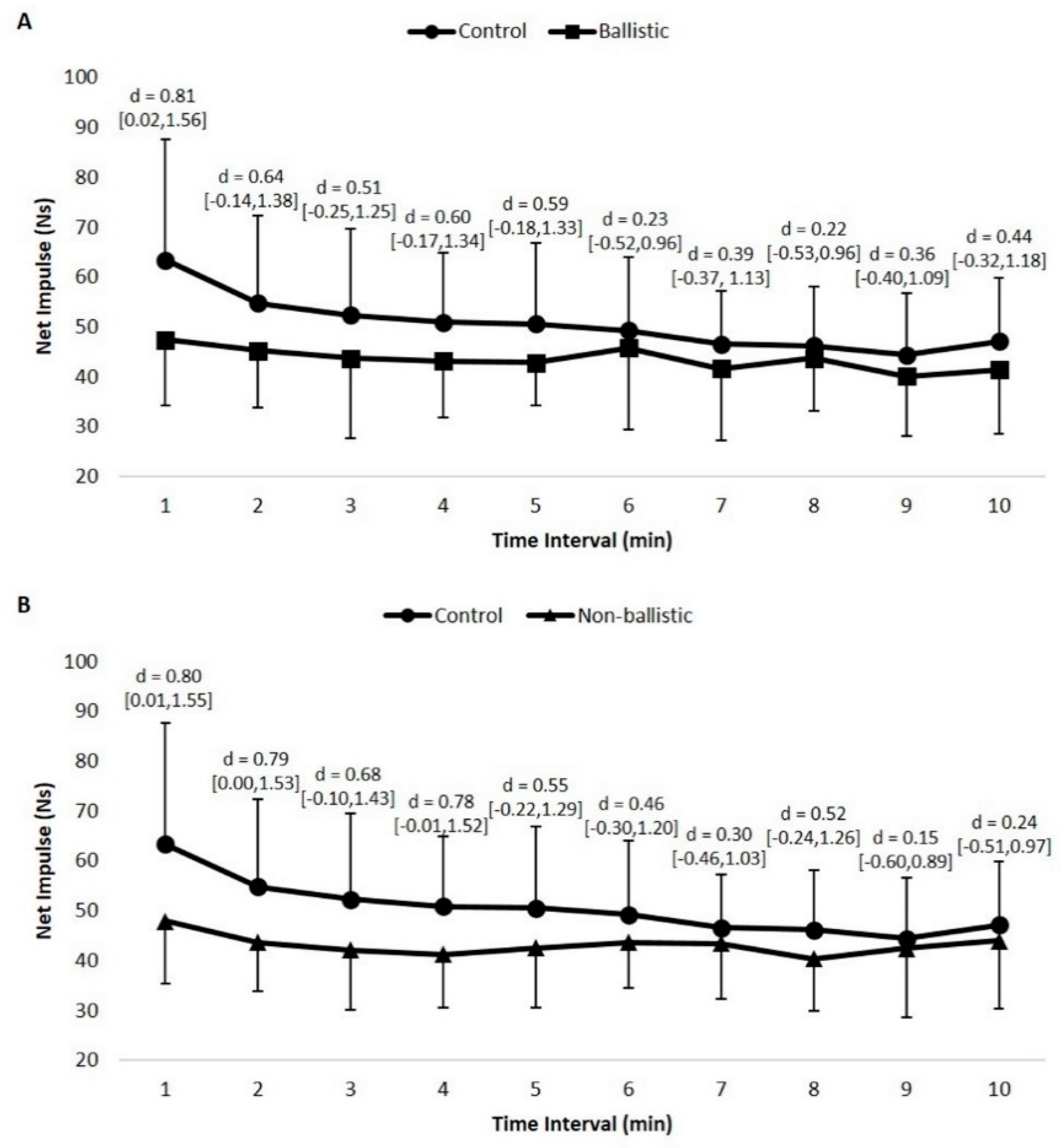Acute Effects of Ballistic and Non-ballistic Bench Press on Plyometric Push-up Performance
Abstract
:1. Introduction
2. Methods
2.1. Experimental Approach to the Problem
2.2. Participants
2.3. Procedures
2.3.1. 1RM Bench Press Testing Session
2.3.2. 1RM Concentric-Only Bench Press Testing Session and Familiarization
2.3.3. Control Testing Session
2.3.4. Ballistic and Non-Ballistic Testing Sessions
2.4. Data and Statistical Analysis
3. Results
3.1. Condition Main Effects
3.2. Time Main Effects
3.3. Condition x Time Interaction Effects
4. Discussion
5. Conclusions
Author Contributions
Funding
Conflicts of Interest
References
- Lorenz, D.S.; Reiman, M.P.; Lehecka, B.; Naylor, A. What performance characteristics determine elite versus nonelite athletes in the same sport? Sports Health 2013, 5, 542–547. [Google Scholar] [CrossRef]
- Newton, R. Developing maximal neu romuscular power: Part 2—Training considerations for improving maximal power production. Sports Med. 2011, 41, 125–146. [Google Scholar]
- Suchomel, T.J.; Nimphius, S.; Bellon, C.R.; Stone, M.H. The importance of muscular strength: Training considerations. Sports Med. 2018, 48, 765–785. [Google Scholar] [CrossRef]
- Robbins, D.W. Postactivation potentiation and its practical applicability: A brief review. J. Strength Cond. Res. 2005, 19, 453. [Google Scholar] [CrossRef]
- Robbins, D.W.; Young, W.B.; Behm, D.G.; Payne, W.R. Effects of agonist–antagonist complex resistance training on upper body strength and power development. J. Sports Sci. 2009, 27, 1617–1625. [Google Scholar] [CrossRef]
- Suchomel, T.J.; Sato, K.; DeWeese, B.H.; Ebben, W.P.; Stone, M.H. Potentiation effects of half-squats performed in a ballistic or nonballistic manner. J. Strength Cond. Res. 2016, 30, 1652–1660. [Google Scholar] [CrossRef]
- Suchomel, T.J.; Sato, K.; DeWeese, B.H.; Ebben, W.P.; Stone, M.H. Potentiation following ballistic and nonballistic complexes: The effect of strength level. J. Strength Cond. Res. 2016, 30, 1825–1833. [Google Scholar] [CrossRef]
- Baker, D. Acute effect of alternating heavy and light resistances on power output during upper-body complex power training. J. Strength Cond. Res. 2003, 17, 493. [Google Scholar]
- West, D.J.; Cunningham, D.J.; Crewther, B.T.; Cook, C.J.; Kilduff, L.P. Influence of ballistic bench press on upper body power output in professional rugby players. J. Strength Cond. Res. 2013, 27, 2282–2287. [Google Scholar] [CrossRef]
- Bevan, H.R.; Owen, N.J.; Cunningham, D.J.; Kingsley, M.I.; Kilduff, L.P. Complex training in professional rugby players: Influence of recovery time on upper-body power output. J. Strength Cond. Res. 2009, 23, 1780–1785. [Google Scholar] [CrossRef]
- Evetovich, T.K.; Conley, D.S.; McCawley, P.F. Postactivation potentiation enhances upper-and lower-body athletic performance in collegiate male and female athletes. J. Strength Cond. Res. 2015, 29, 336–342. [Google Scholar] [CrossRef]
- Fukutani, A.; Takei, S.; Hirata, K.; Miyamoto, N.; Kanehisa, H.; Kawakami, Y. Influence of the intensity of squat exercises on the subsequent jump performance. J. Strength Cond. Res. 2014, 28, 2236–2243. [Google Scholar] [CrossRef]
- Crewther, B.T.; Kilduff, L.P.; Cook, C.J.; Middleton, M.K.; Bunce, P.J.; Yang, G.-Z. The acute potentiating effects of back squats on athlete performance. J. Strength Cond. Res. 2011, 25, 3319–3325. [Google Scholar] [CrossRef]
- Jensen, R.L.; Ebben, W.P. Kinetic analysis of complex training rest interval effect on vertical jump performance. J. Strength Cond. Res. 2003, 17, 345–349. [Google Scholar]
- Mola, J.N.; Bruce-Low, S.S.; Burnet, S.J. Optimal recovery time for postactivation potentiation in professional soccer players. J. Strength Cond. Res. 2014, 28, 1529–1537. [Google Scholar] [CrossRef]
- Kilduff, L.P.; Bevan, H.R.; Kingsley, M.I.; Owen, N.J.; Bennett, M.A.; Bunce, P.J.; Hore, A.M.; Maw, J.R.; Cunningham, D.J. Postactivation potentiation in professional rugby players: Optimal recovery. J. Strength Cond. Res. 2007, 21, 1134–1138. [Google Scholar] [CrossRef]
- Brandenburg, J.P. The acute effects of prior dynamic resistance exercise using different loads on subsequent upper-body explosive performance in resistance-trained men. J. Strength Cond. Res. 2005, 19, 427. [Google Scholar]
- Farup, J.; Sørensen, H. Postactivation potentiation: Upper body force development changes after maximal force intervention. J. Strength Cond. Res. 2010, 24, 1874–1879. [Google Scholar] [CrossRef]
- Suchomel, T.J.; Lamont, H.S.; Moir, G.L. Understanding vertical jump potentiation: A deterministic model. Sports Med. 2016, 46, 809–828. [Google Scholar] [CrossRef]
- Newton, R.U.; Kraemer, W.J.; Häkkinen, K.; Humphries, B.J.; Murphy, A.J. Kinematics, kinetics, and muscle activation during explosive upper body movements. J. Appl. Biomech. 1996, 12, 31–43. [Google Scholar] [CrossRef]
- Suchomel, T.; Taber, C.; Sole, C.; Stone, M. Force-time differences between ballistic and non-ballistic half-squats. Sports 2018, 6, 79. [Google Scholar] [CrossRef]
- Lake, J.; Lauder, M.; Smith, N.; Shorter, K. A comparison of ballistic and nonballistic lower-body resistance exercise and the methods used to identify their positive lifting phases. J. Appl. Biomech. 2012, 28, 431–437. [Google Scholar] [CrossRef]
- Seitz, L.B.; Trajano, G.S.; Haff, G.G. The back squat and the power clean: Elicitation of different degrees of potentiation. Int. J. Sports Physiol. Perform. 2014, 9, 643–649. [Google Scholar] [CrossRef]
- Hopkins, W. A Scale of Magnitudes for Effect Statistics. A New View of Statistics. 2002. Available online: http://sportsci.org/resource/stats/effectmag.html (accessed on 15 January 2019).
- Tillin, N.A.; Bishop, D. Factors modulating post-activation potentiation and its effect on performance of subsequent explosive activities. Sports Med. 2009, 39, 147–166. [Google Scholar] [CrossRef]
- Suchomel, T.J.; Sato, K.; DeWeese, B.H.; Ebben, W.P.; Stone, M.H. Relationships between potentiation effects after ballistic half-squats and bilateral symmetry. Int. J. Sports Physiol. Perform. 2016, 11, 448–454. [Google Scholar] [CrossRef]
- West, D.W.; Burd, N.A.; Staples, A.W.; Phillips, S.M. Human exercise-mediated skeletal muscle hypertrophy is an intrinsic process. Int. J. Biochem. Cell 2010, 42, 1371–1375. [Google Scholar] [CrossRef]



© 2019 by the authors. Licensee MDPI, Basel, Switzerland. This article is an open access article distributed under the terms and conditions of the Creative Commons Attribution (CC BY) license (http://creativecommons.org/licenses/by/4.0/).
Share and Cite
Bodden, D.; Suchomel, T.J.; Lates, A.; Anagnost, N.; Moran, M.F.; Taber, C.B. Acute Effects of Ballistic and Non-ballistic Bench Press on Plyometric Push-up Performance. Sports 2019, 7, 47. https://doi.org/10.3390/sports7020047
Bodden D, Suchomel TJ, Lates A, Anagnost N, Moran MF, Taber CB. Acute Effects of Ballistic and Non-ballistic Bench Press on Plyometric Push-up Performance. Sports. 2019; 7(2):47. https://doi.org/10.3390/sports7020047
Chicago/Turabian StyleBodden, David, Timothy J. Suchomel, Ally Lates, Nicholas Anagnost, Matthew F. Moran, and Christopher B. Taber. 2019. "Acute Effects of Ballistic and Non-ballistic Bench Press on Plyometric Push-up Performance" Sports 7, no. 2: 47. https://doi.org/10.3390/sports7020047
APA StyleBodden, D., Suchomel, T. J., Lates, A., Anagnost, N., Moran, M. F., & Taber, C. B. (2019). Acute Effects of Ballistic and Non-ballistic Bench Press on Plyometric Push-up Performance. Sports, 7(2), 47. https://doi.org/10.3390/sports7020047




